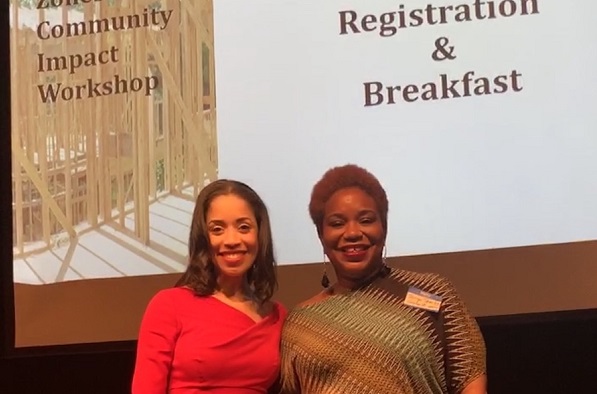 City Council Member Amanda Edwards and GlobeSt.com reporter Tanya Sterling
City Council Member Amanda Edwards and GlobeSt.com reporter Tanya Sterling
Houston, TX—Hundreds of residents, investors, developers, bankers, civic leaders and government officials attended an Opportunity Zones and Community Impact Workshop on February 15 at the Council of Recovery near downtown Houston. The purpose of the workshop, held by Houston's Local Initiatives Support Corporation (LISC) and Houston City Council Member, Amanda Edwards (At-Large 4), was to invite all interested parties to the table to discuss Opportunity Zones and learn how they will impact designated communities in the Houston area. Panelists at the event included Amanda Timm, Houston LISC, Council Member Amanda Edwards as well as Larry Jacobs and Ross Baird, both with the Kauffmann Foundation.
“Now is the time to have these discussions with residents as a number of these Opportunity Zone areas here in Houston have high levels of poverty,” said Council Member Amanda Edwards.
Each state designated 25% of local areas as Opportunity Zones. There are 99 designated tracts in the City of Houston and 105 tracts in the surrounding Harris County. In these areas, the income level is one half lower than the greater Houston area median with the poverty rate hovering at 33.5% and the unemployment rate at 13.3%.
Individuals living in the Opportunity Zones wondered how these investments would affect them as local residents and business owners. They also wanted to ensure that oversight, on the community level, would be present to prevent gentrification or displacement. Conversely, an attendee commented they lived in an area that was not a certified tract and they wanted to determine how their community could become a designated tract. A common question was how local communities would track these investments as well as have access to opportunities in which they can invest.
“Community members are also interested in opportunities to invest in their own neighborhood,” Edwards said. “Some business owners and residents want to be involved and financially commit to the area in which they live in and/or work.”
Community leaders also expressed concerns such as investors not being familiar with the designated areas and investors needing to be aware of projects in the zones that directly benefits the actual community.
As the workshop progressed, investors asked how they could familiarize themselves with the various Opportunity Zones and what information was available so they could discern the level of of risk associated with an associated project.
“The City of Houston will provide economic development tools to investors who are interested in investing in community friendly ways in under-resourced areas,” Edwards said. “I would also love to see the creation of a marketplace to connect investors with projects.”
Panelists and attendees also discussed how there can be an increased access to capital for area minorities and women-owned businesses so that they too can invest in Opportunity Zones. One clear takeaway from the workshop is that communities and their leaders will somewhat bear the brunt of the success of Opportunity Zone investments. Those who live and work in these designated tracts will essentially become a part of the investment and ensure its success.
© Touchpoint Markets, All Rights Reserved. Request academic re-use from www.copyright.com. All other uses, submit a request to [email protected]. For more inforrmation visit Asset & Logo Licensing.






